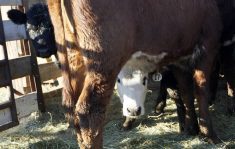BSE has cost the United States 5,000 jobs, three packing plants and about $1.9 billion US in lost beef sales.
An unpublished study from Kansas State University found that the impact was more regional in scope, depending on whether plants were dependent on Canadian live trade.
Overall, Canadian cattle represented only three percent of the U.S. total slaughter.
“The Canadian cattle represent significant amounts of cattle in certain states and certain packing plants, but for the entire U.S. supply it is a very small percentage,” said Kansas State agricultural economist Ted Schroeder, who led the study.
Read Also

Saskatchewan dairy farm breeds international champion
A Saskatchewan bred cow made history at the 2025 World Dairy Expo in Madison, Wisconsin, when she was named grand champion in the five-year-old Holstein class.
The study covered the period between May 20, 2003 and the present. All live trade with Canada was halted on that date after the federal government announced that BSE had been discovered in an Alberta cow.
The Americans lost access to about 50 international markets when a second case was reported in Washington state Dec. 23, 2003, in a cow that was traced back to Canada.
The Canadian Cattlemen’s Association was among a group of organizations supporting the study, which confirmed what many already suspected.
Many U.S. plants that relied on Canadian cattle and normally operate 80 hours per week have had to reduce work to 20 hours per week, said CCA executive vice-president Dennis Laycraft.
With a surplus of cattle in Canada and a shortage in the U.S., Laycraft said the consequences could have broad implications.
“The longer this border remains closed, plants will open here and some will close there,” he said. “What we are seeing is independents went out of business. It is taking competition out of the U.S. business.”
According to Canfax, exports of all classes including steers, heifers, cows and bulls for 2001 were slightly more than one million head, consisting of nearly 710,000 young animals and slightly more than 311,000 mature cattle.
In 2002, more than one million left Canada but drought forced more mature cattle into the market, resulting in 430,000 cows and bulls and 595,000 young animals being shipped to specific states for slaughter.
The study found Canada supplied Utah with 30 percent of its total slaughter supply. Nineteen percent of Washington’s total slaughter came from Canada.
In 2002, Minnesota, Michigan and New Jersey each used more than 10 percent Canadian cattle. They were mostly dairy cattle from Eastern Canada.
Washington, Pennsylvania, Michigan and Utah each imported 100,000 head for slaughter in 2002.
The study found that Canadian cattle represented more than $950 million in total sales value of beef and byproducts.
“That essentially is no longer here,” Schroeder said. “You start talking about $100 million of sales value that used to be in a state, you really start to talk about a substantial reduction in employment and other sources of related activities related to the processing industry.”
Washington, Utah and Nebraska probably lost $200 million each in meat and byproduct sales in the last 18 months.
Finding replacement slaughter cattle has not worked well. Buyers sought cattle further afield but transportation barriers and costs are restrictive.
“Those three states would have to go to areas where there are more cattle in the southwest and compete against other bidders in areas where the processors were already short of cattle,” Schroeder said.
There was also a shortage of feeder calves. More Mexican feeders arrived but provided only about half of what was needed.
“Even though we tried to offset some of this closure by increasing our imports of feeder cattle from Mexico, that still didn’t replace the feeder calves,” he said.
Consequently, plants are operating well below capacity and three have closed. Some communities depend on these plants and job losses have affected local incomes and related industries.
Schroeder believes the U.S. is going to lose processing capacity because packers can’t run costly plants below capacity.
“The U.S. will lose in a very painful transition, some of these processors in some of these areas where there isn’t a lot of processing capacity available.”
That could happen in Washington, Minnesota or Utah.
As well, American companies could suffer if Canadians build more of their own plants.
“If these Canadian investments continue, we are going to realize we have excess slaughter capacity in North America,” he said.
He wondered about the outcome of this overinvestment.
“It might in the short run be a good thing for producers as guys are competing vigorously for cattle, but as soon as they start going under, that won’t be a good situation at all,” he said.
“It could be devastating to local communities again that have invested in those facilities.”
He said Canada may become efficient enough to accept U.S. cattle for slaughter. Canada’s identification program and other food safety regulations give it strategic advantages over the U.S., he added.















